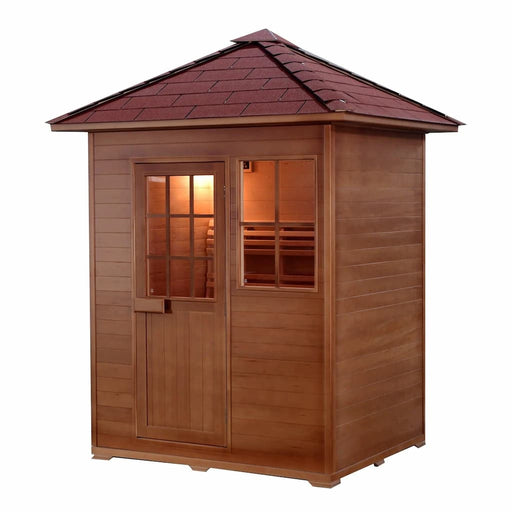5 Easy Facts About Traditional Sauna Described
5 Easy Facts About Traditional Sauna Described
Blog Article
Excitement About Traditional Sauna
Table of ContentsThe Greatest Guide To Traditional SaunaTop Guidelines Of Traditional SaunaTraditional Sauna for DummiesThe smart Trick of Traditional Sauna That Nobody is Talking About
The majority of the weight shed in a sauna is water loss and is re-gained upon rehydrating. Nonetheless, certainly sauna can be an important part of a healthy and balanced weight-loss program. To look at the distinctions in between standard and IR saunas, I will separate these right into proven, theoretical, and fabricated distinctions.Therefore, the most popular point in the saunawhich goes to the ceiling straight above the sauna heateris generally between 185 and 190 F. Traditional Sauna. Claims that a traditional sauna goes beyond 200 F is just not true and not appropriate for electric saunas offered in the US. The temperature level for a far-infrared sauna is generally established between 120 and 140 F; nonetheless, unlike the standard sauna, the goal in and IR area is not to attain a high temperature level
Since of this, the temperature distinction is practically irrelevant, given that excessive sweating causes both sauna types, but the technique of heating the body is various. In an IR sauna the bather will really feel hot and will sweat a lot, but at a lot lower temperature levels. Therefore, if the objective is to spend longer durations of time in the sauna, the IR sauna is a great selection.

Excitement About Traditional Sauna
When the high temperature is attained, the components cycle on and off to maintain the heat. Many standard sauna individuals appreciate putting water over the rocks to develop vapor to elevate sauna moisture degrees. The advantages of putting water over the rocks include: making the space much more comfortable, moistening the nasal passages, and allowing the usage of aromatherapy by blending crucial oils with the water.
In a far-infrared sauna, the heat waves permeate the body to successfully heat up the body and increase the body core temperature. To accomplish this boosted temperature, Far-infrared emitters produce infrared energy which is close to the same wavelength as that which the body naturally emitsoften described as the "Vital Range" of 7 to 14 microns), so the energy is well obtained by the body.
When the power enters the body, it causes the body temperature level to raise and inevitably causes sweating. In an infrared sauna it is necessary for the emitters/heaters to stay on practically continuously. Because there is no mass of rocks to retain warmth, the sauna will certainly cool if the emitters turned off.
As pointed out over, the sauna bather in an infrared area intends to place himself in front of running emitters to obtain maximum take advantage of the warm. The heating time for both areas can be really different, depending upon how the areas are utilized. For a conventional sauna, a bather should permit 30-40 minutes for the area to accomplish a desired temperature level and to appropriately pre-heat the rocks.
Some Of Traditional Sauna
A well created sauna will generally attain a temperature of 150-160 F in regarding 30-40 mins (Traditional Sauna). For hotter temperatures, the space might need to heat for a longer duration. Once the area attains set temperature level, the heating unit will cycle on and off, typically running regarding 50% of the moment. The insulated walls and the warmed rocks will certainly keep the room hot and at steady temperature levels.
To some, 15 mins was "thrown away" while the infrared energy heated the wood panels instead of heating up a body, while others locate a pre-heated area to be much more comfortable and believe a raised beginning temperature level is essential to start sweating. The size of recommended use for each space is approximately the same (10-15 minutes per session); however, due to the lower air temperatures and the ability to feel the effects of infrared heat faster than a conventional sauna, it is not uncommon for a person to spend a total of 20-30 minutes in an infrared sauna.
Conventional saunas have a tendency to be bigger (hence make use of even more power) than try this web-site infrared saunas, although standard saunas are definitely available in one and two person dimensions also. For a two-person conventional sauna, 5x6 or 5x7 size is most preferred. The top bench can conveniently seat two or 3 people and is also long enough to exist down during the sauna session.


The typical price per kWH of electrical energy in the U.S. is around $0.11, so a 4.5 kW heater will certainly set you back roughly $.50 to compete one hour, if the heater runs continually for one hour. Generally a sauna heating system will run for 75% of the initial hour and 50% of subsequent hours on considering that the elements cycle once the set temperature level is achieved.
Getting The Traditional Sauna To Work
A 2 individual far-infrared area is usually physically smaller than a typical sauna, frequently regarding 4' x 4' or smaller. The IR heating unit is generally 1.5-1.7 kW utilizing a 120 volt 15 amp plug-in solution. Considering that her comment is here the area can be made use of earlier than a sauna room, we will assume the room is used for to of an hour including warm up time.
Finally, there is a seldom discussed difference in the social experience in between both areas. While our culture has lost several of the anchor social advantage of the typical sauna experience, it can be really socially fulfilling. From family members time in the sauna, to heart-felt discussions with better halves, to sauna partiesthe standard sauna experience can cause intimate interacting socially.
The majority of higher end infrared areas include tinted light treatment, sound systems and full-glass fronts.
Report this page